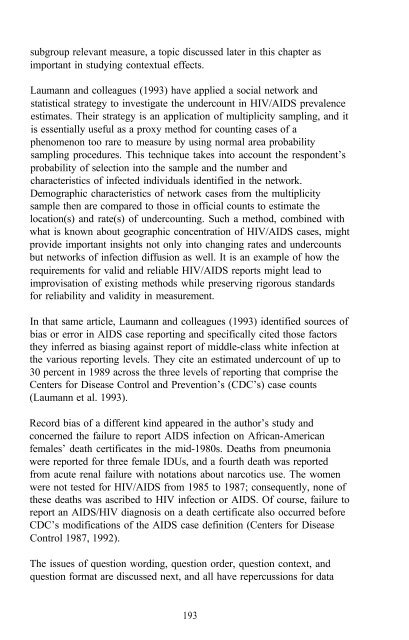The Context of HIV Risk Among Drug Users and Their Sexual Partners
The Context of HIV Risk Among Drug Users and Their Sexual Partners
The Context of HIV Risk Among Drug Users and Their Sexual Partners
You also want an ePaper? Increase the reach of your titles
YUMPU automatically turns print PDFs into web optimized ePapers that Google loves.
subgroup relevant measure, a topic discussed later in this chapter as<br />
important in studying contextual effects.<br />
Laumann <strong>and</strong> colleagues (1993) have applied a social network <strong>and</strong><br />
statistical strategy to investigate the undercount in <strong>HIV</strong>/AIDS prevalence<br />
estimates. <strong>The</strong>ir strategy is an application <strong>of</strong> multiplicity sampling, <strong>and</strong> it<br />
is essentially useful as a proxy method for counting cases <strong>of</strong> a<br />
phenomenon too rare to measure by using normal area probability<br />
sampling procedures. This technique takes into account the respondent’s<br />
probability <strong>of</strong> selection into the sample <strong>and</strong> the number <strong>and</strong><br />
characteristics <strong>of</strong> infected individuals identified in the network.<br />
Demographic characteristics <strong>of</strong> network cases from the multiplicity<br />
sample then are compared to those in <strong>of</strong>ficial counts to estimate the<br />
location(s) <strong>and</strong> rate(s) <strong>of</strong> undercounting. Such a method, combined with<br />
what is known about geographic concentration <strong>of</strong> <strong>HIV</strong>/AIDS cases, might<br />
provide important insights not only into changing rates <strong>and</strong> undercounts<br />
but networks <strong>of</strong> infection diffusion as well. It is an example <strong>of</strong> how the<br />
requirements for valid <strong>and</strong> reliable <strong>HIV</strong>/AIDS reports might lead to<br />
improvisation <strong>of</strong> existing methods while preserving rigorous st<strong>and</strong>ards<br />
for reliability <strong>and</strong> validity in measurement.<br />
In that same article, Laumann <strong>and</strong> colleagues (1993) identified sources <strong>of</strong><br />
bias or error in AIDS case reporting <strong>and</strong> specifically cited those factors<br />
they inferred as biasing against report <strong>of</strong> middle-class white infection at<br />
the various reporting levels. <strong>The</strong>y cite an estimated undercount <strong>of</strong> up to<br />
30 percent in 1989 across the three levels <strong>of</strong> reporting that comprise the<br />
Centers for Disease Control <strong>and</strong> Prevention’s (CDC’s) case counts<br />
(Laumann et al. 1993).<br />
Record bias <strong>of</strong> a different kind appeared in the author’s study <strong>and</strong><br />
concerned the failure to report AIDS infection on African-American<br />
females’ death certificates in the mid-1980s. Deaths from pneumonia<br />
were reported for three female IDUs, <strong>and</strong> a fourth death was reported<br />
from acute renal failure with notations about narcotics use. <strong>The</strong> women<br />
were not tested for <strong>HIV</strong>/AIDS from 1985 to 1987; consequently, none <strong>of</strong><br />
these deaths was ascribed to <strong>HIV</strong> infection or AIDS. Of course, failure to<br />
report an AIDS/<strong>HIV</strong> diagnosis on a death certificate also occurred before<br />
CDC’s modifications <strong>of</strong> the AIDS case definition (Centers for Disease<br />
Control 1987, 1992).<br />
<strong>The</strong> issues <strong>of</strong> question wording, question order, question context, <strong>and</strong><br />
question format are discussed next, <strong>and</strong> all have repercussions for data<br />
193
















